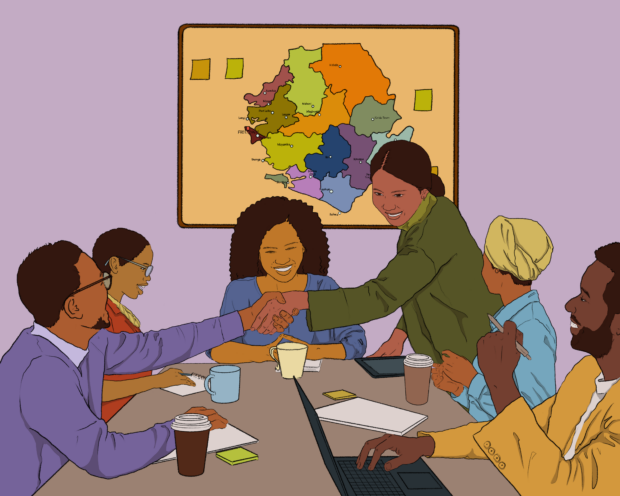With a booming youth population and rapid urbanization, Africa is undergoing extraordinary demographic changes. By 2030, Africans will make up roughly 50% of new workers globally. Yet these shifts are coupled with a distressing lack of economic growth. If current trends persist, Africans are projected to account for 80% of those living in poverty globally by 2030 (compared to 14% in 1990). In large part, this is due to the continent’s shrinking purchasing power parity (PPP), which sits at roughly 25% that of the world’s average.
These inequalities, further exacerbated by decreasing foreign investment and worsening climate disasters, will only continue to worsen in the coming years – unless swift and comprehensive action is taken.
Pressing development challenges persist, but digital transformation offers a path forward.
While there’s no silver bullet that can single handedly address every development challenge Africa faces, digital technology, when responsibly harnessed, leveraged, and governed, can play an outsized role in bridging key development gaps. Today, digital tools and solutions are addressing food insecurity; providing people with early warnings of impending natural disasters; and advancing financial inclusion for women in low resource communities.
With so many opportunities, digital transformation can drive the economic and social gains the continent urgently needs. Just look at India, where the government has fostered widespread digital and financial inclusion by putting in place robust digital foundations. By 2026, India’s digital economy is projected to account for 20% of national GDP – up from a mere 4.5% in 2014. With a similar approach, Africa could see comparable results. But to do so, the continent will need to make important advancements, not only in how it harnesses data and digital technology, but also in the accompanying policies, regulations, and safeguards needed to ensure people benefit from their power.
In short, Africa sits at a critical juncture, faced with a transformative – but rapidly closing – window of opportunity. With this incredible potential, will governments and international actors take advantage of the development gains that smart digital technology investments can enable?
We can bridge the development gap, but only if there’s the collective will to make it happen.
As I think about Africa’s digital future, I see three ways this could play out – each with important implications for not only the continent but also the rest of the world.
Scenario 1: There are no real improvements to the status quo.
Without the increased investment needed to finance strong digital foundations, existing digital and data divides will continue to deepen. This inequality will be particularly stark in Africa, as the region with the fastest growing population and, simultaneously, the lowest levels of global connectivity. In fact, by 2050, the region is projected to be home to 2.5 billion people, equivalent to over 25% of the global population. Yet, connectivity rates, which today hover around 43%, will continue to lag far behind the global average.
Further compounding the problem is a lack of affordable device access. Today, in Africa, the price of a smartphone is equivalent to 62.8% of average monthly income. Even with growing connectivity zones, Africa’s changing demographics – when coupled with stagnant economic prospects – could result in even more people being excluded from the benefits that digitalization can offer.
In such a scenario, those offline will remain persistently outside opportunity zones for education, digital health, market access, public benefits, financial services, and more. The destabilizing impact of such persistent inequality, as we know from history, can be enormous and consequential — resulting in political instability, social upheaval, and, critically, an accelerating development gap.
Scenario 2: There are gains in development and digital participation, but power imbalances – and mistrust – persist.
In this future, governments and investors come together, prioritizing the estimated $97 billion dollar investment needed to advance universal, affordable broadband access across the continent. The digital and development gaps meaningfully shrink, facilitating incredible real-world benefits such as greater financial and gender inclusion.
But, without the policies, safeguards, and institutional capacity needed to accompany new innovations, digital technology – while bridging key developments gaps – creates problems of its own. Lacking these structures, those newly online begin to feel the familiar negative effects that many of us face today: Concentrated power in the hands of a few corporate and government actors. Growing concern about misinformation. Loss of online anonymity. Perhaps even fear of surveillance. And, at a societal level, low-income countries are still unable to leverage the full power of data for their economic and social needs.
All of these issues point back to the same underlying problem: an environment in which the non-technical elements of good digital transformation are missing. Here, the power of data collection and sharing is hoarded by governments and big corporations, hindering people from maximizing the value of the information they generate. And, as a result, people lack any kind of real redressal, as data governance rules aren’t established, harmonized, or enforced.
Scenario 3: There are real changes in the digital ecosystem that enable people to reap maximum value from data and digital technology.
Digital transformation bridges key development gaps, while also promoting inclusion, trust, and meaningful participation for people across the continent.
In this future, people are able to leverage data and digital technology for countless solutions and services – from applying for a loan, to accessing personalized medical guidance, to facilitating more efficient farming and fishing practices. And, just as importantly, robust digital and data infrastructure foster the innovation and competition needed to fuel urgently needed job growth.
These successes are thanks to effective safeguards and an enabling environment that provide people with choice and agency around the digital tools they use. Comprehensive data policies, effective redressal mechanisms, and institutional oversight give people confidence in the ways their data is being stored and shared to create value. With these elements in place, technology companies, governments, and other data owners are held to high standards of transparency and accountability – mitigating risk of harm or misuse.
The path forward depends on several key factors.
With such high stakes, there are several factors that will be critical in tipping the scales towards a future of social and economic growth, underpinned by robust data and digital infrastructure.
First is funding. Public sector funding has proven critical to unlocking the much larger private sector investments to create the broadband, digital payments, and data infrastructure required for full digital inclusion. In the coming years, debt-burdened countries will increasingly look to international donors and financial institutions to underwrite and de-risk this infrastructure. We can only hope that the U.S. pause on foreign assistance is temporary given America’s outsized position on foreign aid and investment. But, in the meantime, the role of private philanthropy will be even greater.
Second is data policy and governance. Shifting from scenario two to three is largely dependent on the collective will to align around a vision of data empowerment and data sharing for public benefit. Policies and regulations will need to be enhanced to support cross-border data sharing agreements; staffing and budgetary independence for data protection authorities; policies that broaden the benefits of data beyond those who currently hold it; and infrastructure that allows data to move transparently across institutions using shared protocols.
Third are the enablers of business growth. Good digital infrastructure and data governance can unlock massive market opportunities for big business and innovators alike, while building trust and opportunities for people more directly. But these market actors will need the necessary components – like investment capital, human capacity, regulatory ease, and more – to realize this potential for economic growth.
The next decade will define Africa’s economic and digital future for years to come. Inaction isn’t an option.
At this critical crossroads, the stakes for meaningful development couldn’t be higher.
For Africans, getting it right means advancing a digital society where some of the most vulnerable and underserved communities reap tangible benefits from the extraordinary power of data and digital technology. While getting it wrong could result in more than a quarter of the world’s population being excluded from future job opportunities, critical economic growth, and financial inclusion.
In 2025, my team and I are working to advance the policies, frameworks, and collective understanding needed through projects in Ethiopia, Nigeria, Sierra Leone, and more. But we can’t do it alone.
This may very well be our best – and last – foreseeable opportunity to close the continent’s pressing economic and development gaps. Let’s not waste it.






